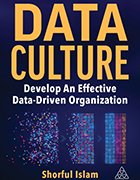Why data-driven operations must measure data culture
Many organizations know what data culture is, but measuring culture levels and identifying necessary improvements is another challenge.
Organizations that want to be data driven need a strong data culture. Leadership must implement processes that measure cultural progress and identify areas to improve on an ongoing basis.
Instilling a culture of data use and experimentation starts with actions -- not words -- at the top. Executives must understand their current culture level and take the necessary steps to foster a data-friendly culture. Employees need resources to learn and train with data to become more comfortable and confident using it in daily workflows. The process requires constant evaluation and adjustment based on progress.
In Data Culture: Develop An Effective Data-Driven Organization, published by Kogan Page, Shorful Islam shares his experiences with leaders that talk the talk, but don't walk the walk.
"I have seen too many instances of senior leadership talking about and promoting data-related initiatives in their organization," Islam writes. "Every other presentation they do mentions the use of data. However, there is no genuine intention to be data-driven."
Good data culture encourages employees, regardless of technical skill, to engage and experiment with data in their daily duties. It shifts the decision-making process from considering data as one of the factors to making data the primary driver of decisions. If gut feelings, assumptions or personal opinions supersede data in the decision-making process, then the organization does not have a data-driven culture.
Islam details how leadership can establish, cultivate and maintain data culture in their organization. Each organization faces unique challenges during the process of developing data culture, whether they're starting from scratch, or trying to change an existing culture. Islam breaks down the nuances of both situations.
He interviewed data leaders for his book and, in Chapter 9: Measuring a Healthy Data Culture, he suggests eight ways to understand the state of data culture based on their responses. Suggestions include making sure there's a person from the data team in every meeting and ensuring that the business has a sensible number of KPIs to refer to in the decision-making process.
In Chapter 9 of Data Culture: Develop An Effective Data-Driven Organization, Shorful Islam explores what a healthy data culture looks like and examples of what behaviors and actions to look for. Check out the following excerpt from Chapter 9 to learn more about measuring data culture.
Measuring a healthy data culture
With data culture, just observing the behaviour is not enough. The intention should also be the desire to be a data-driven organization. Defining a healthy data culture is often hard in terms of quantification and, like all cultures, it is often what is observed as the norm that defines the status of a culture. The data leaders I interviewed for this book suggested a number of ways to understand the state of your data culture:
- Is there a person from the data team in every meeting? Is the voice of data heard in those forums?
- Does the business have a sensible number of KPIs which they refer to in order to make decisions?
- Does the business care about data? Do C-suite leaders use the dashboards? Does the CEO value these dashboards without always questioning their value?
- Does the business use data from a single source of truth and point to it when evaluating performance?
- Does the business stay consistent in its use of data and not use third-party data to make a point and contradict internal data?
- Is the organization confident in the data and its accuracy?
- Is the language used around data positive, where benefits are mentioned more than challenges?
- Is the data team seen as a benefit to the organization and not always referred to as a cost centre?
Again, this starts at the top, so as a data leader you need to continuously ensure that top leadership remains committed to the data culture. Leadership should consistently promote data-driven practices and set an example. I'm not sure you can set a KPI or measure this behaviour systematically, but it should be observable in your organization. Senior leaders should more often than not be data-driven in their regular decision-making and more so when it comes to the most critical decisions.
Beyond referring to data for decision-making, they should also encourage data-driven projects, and proactively promote the initiation of data-driven projects that showcase the value of the organization's data culture. For example, where a new reporting or data visualization solution is being deployed, or a new predictive model is being built, senior leaders should acknowledge their development and speak of the benefits they will bring to the organization. The engagement with these projects helps sustain enthusiasm and momentum as they show the rest of the business that the leadership is still engaged with data. Another observable behaviour should be the celebration and recognition of teams and individuals who achieve significant outcomes through data-driven initiatives. Public recognition reinforces the importance of a healthy data culture. This should occur often enough that people can very easily recall the last time the data team was recognized. As a data leader, it is worth using these instances of being recognized to baseline the significance of data in the organization and encourage senior leadership about the importance of recognizing the data team for their work when interest in data may be waning.
However, a word of caution is also needed. I have seen too many instances of senior leadership talking about and promoting data-related initiatives in their organization. Every other presentation they do mentions the use of data. However, there is no genuine intention to be data-driven. From an observable metric of senior leadership encouraging and promoting data initiatives this seems to be happening, but in reality there may not be the actions to back up those mentions and the organization does not move forward with being data-driven. These should be followed up with resources and budget to realize these initiatives. As a data leader, you will note how often words turn into action and set a benchmark for how seriously the senior leadership, and therefore the organization, has established a data culture.
There should also be a general consensus in the organization that data is embedded in processes. What this should look like is that data is integrated into existing business processes and decision-making practices. This ensures that data is consistently considered in day-to-day operations. The way to measure this is twofold, and usually involves the inverse of what a healthy data culture should look like, in other words what a poor data culture looks like. The first way is to quantify how many decisions are made without using data. This will become obvious once the decision has been executed and the question of how it performed arises. In my experience this is typically when the data team first hears about it. The other is when the data team is an afterthought and is either invited to the meeting at the last minute or consulted after the decision-making meeting and prior to finalizing a decision. (I've even had several cases where I was asked by senior leadership to join a meeting as it was happening, as they had forgotten to invite someone from data.) It's worth in your personal development reviews with your manager to try to quantify how often this happens. If it's only once or twice a year then the organization can be forgiven, but if it happens relatively frequently it suggests a healthy and strong data culture is not present in the organization.
You could also make this systematic by formally and informally collecting feedback from all employees in an organization of their experience of using and interacting with data initiatives. I tried to do this at one agency, which include periodically doing a live survey during some of the company's monthly updates. What is difficult is getting the balance right between people complaining about not getting the data they need and constructive feedback that allows you to assess the strength of the data culture. However, what these surveys did highlight was the improvement in data literacy within this organization, and the use of agreed and correct terms increasing over time, which suggested that a data culture was maturing. I've also monitored how many employees in the organization, outside of the data team, attend data-related training and workshops. A good example is when a marketing or advertising technology is procured. These will often have an analytics module. It is quite telling of a healthy data culture to see how many non-data people complete this training.
In one company I consulted for, I witnessed behaviours which suggested there was a healthy data culture. The data team had developed a series of models that increased the basket size and average revenue per user on their ecommerce platform. What this meant was that the data initiatives were delivering very tangible benefits, and the organization was invested in making sure they performed. This led to meetings where the performance of the models was discussed. Even without the data team needing to be present, it seemed most people had access to the performance measures for this model. There was also frequent discussion about what other data initiatives could be suggested to the data team, and how they could measure success. It was a pleasure to see mature data literacy present in the organization, with a healthy debate around what success would look like and agreeing on success measures.
Seeing how the data team was involved and the collaboration between the different departments in ensuring that data initiatives were successfully implemented was a clear sign of a healthy data culture. Working across this organization, another measure of a healthy data culture was the use of data by most employees in the organization when backing up their ideas. I was very much impressed when I sat in a CRM team meeting at this organization, where the starting point of the meeting was reviewing the performance of past email campaigns, and using that as the basis of future campaigns. What this suggested was that the company had succeeded in establishing a healthy data culture. When ideas were being suggested, most of them had at least some data to back them up. The CRM team would discuss how they had asked for a piece of analysis after they had an idea for a new campaign and how that data supported the idea they were proposing. There was no need for a data analyst to be present at this meeting I attended and each person took ownership for using data.
This excerpt is from Data Culture by Shorful Islam, copyright 2024, and is reproduced and adapted with permission from Kogan Page Ltd. Readers can learn more and purchase the book from the publisher's site.






